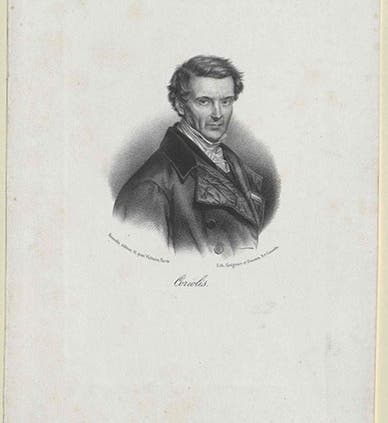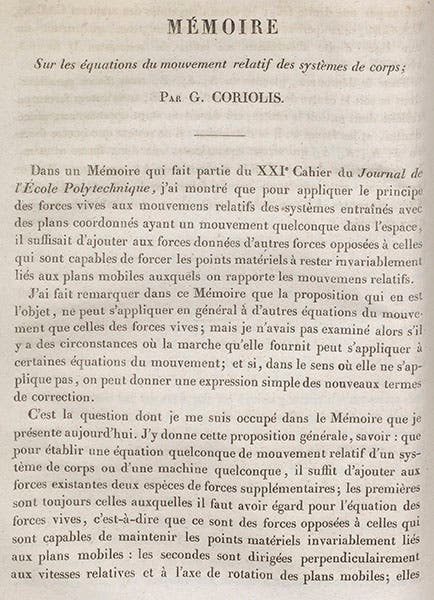Scientist of the Day - Gustave Coriolis
Gaspard-Gustave de Coriolis, a French engineer and mathematician, was born May 21, 1792. Coriolis was a well-respected instructor in the French engineering school system, and has long been recognized as the person who first determined that kinetic energy is correctly given by the expression, 1/2 mv2, and who coined the word "work" to represent the quantity of force times distance. But Coriolis is best known for a paper that he published in 1835, "Sur les équations du mouvement relatif des systems de corps" (”On the equations of relative motion of a system of bodies”). Here he pointed out, among other things, that a body moving radially (toward or away from the center) on a rotating body (like a merry-go-round) will veer to the right or left, when observed from the rotating object, as if there were a force on it (a Coriolis force), even though, to an observer on the ground, it continues in a straight line and feels no force at all. The paper was published in the Journal of the École Polytechnique; since we have it in our serials collection, we thought we would show what it looks like (second image).
The Coriolis force is what physicists call a pseudo force, like centrifugal force, felt in some systems and not in others, unlike gravitational and electro-magnetic forces, which are real forces. Coriolis was concerned in his paper with the forces on water wheels and similar rotating objects, but his reasoning can be applied to a rotating sphere, such as the Earth, to conclude that an object, such as a mass of air, moving north from the equator, will seem to veer to the right to an observer on the rotating Earth (as we all are). This is the famous Coriolis effect, which plays a significant role in the movement of air systems and ocean currents on our planet, a role that was first recognized by meteorologists at the beginning of the 20th century. The cloud patterns shown in the famous “Blue Marble” photograph taken from Apollo 17 in are largely the result of Coriolis forces (third image)
Neither Coriolis nor 20th-century meteorologists said anything about bathtubs, yet there is a persistent belief that the Coriolis effect causes bathtubs in the northern hemisphere to drain with a counter-clockwise swirl, whereas our Australian cousins see a clockwise motion. This is, unfortunately, not true. On the scale of a bathtub, the Coriolis force is several orders of magnitude smaller than just about every other factor influencing the water in the tub, such as the residual motion of the water, so if you see your tub draining counter-clockwise, it is certainly not the result of anything related to M. Coriolis.
We know of only one portrait of Coriolis, an engraving (first image), supposedly based on a painting in the French Academy of Sciences that seems to have no online existence. Coriolis is sometimes dismissed as unworthy of the honor of having a force named in his behalf, as if he just stumbled on his discovery and did not see its implications. However, one should note that when the French erected the Eiffel Tower in 1889 and chose to honor 72 French mathematical scientists by inscribing their names around the side of the first level, Coriolis was one of those chosen, and if you have a good eye, you can spot him right there in the middle of the southwest side (fourth image). These names, scoured by time, used to escape notice, but they were recently repainted in gold (as they had been in 1889), and now they stand out nicely.
Dr. William B. Ashworth, Jr., Consultant for the History of Science, Linda Hall Library and Associate Professor, Department of History, University of Missouri-Kansas City. Comments or corrections are welcome; please direct to ashworthw@umkc.edu.









